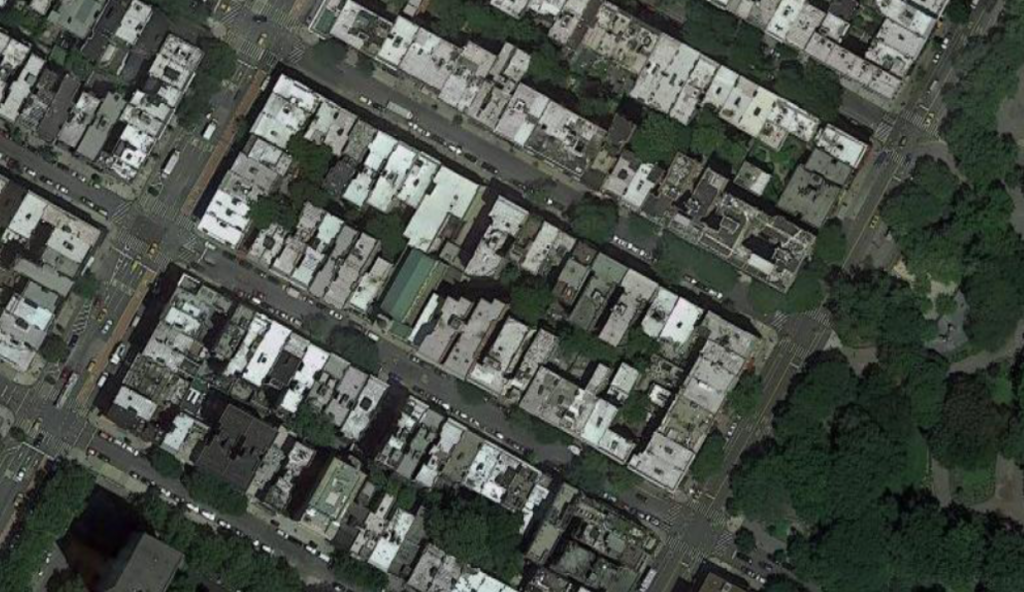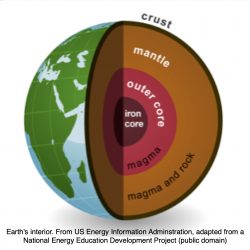Rooftop air conditioning units, midtown, Manhattan. Imagery Google Maps, ©2019 Bluesky, Maxar Technologies, Sanborn, USDA Farm Service Agency, Map data ©2019
A hot day in New York City
People who were there will remember Saturday, July 20, 2019, as a really hot day in New York City. Although it was not the hottest day on record, the temperature at Kennedy airport reached 96ºF (36ºC). On the street at Union Square in Manhattan, a large thermometer (known as BAT, the “Big-Ass Thermometer”) registered a murderous 110ºF. Fire hydrants were opened, and children (and some adults) gladly got soaked to cool off. According to the New York Post, a woman who lives blocks from the ocean in Far Rockaway brought her three children to McCarren Park Pool in Brooklyn, a 90 minute bus ride, to avoid the hot sand on the beach. When she got there it was so crowded that she had to wait 45 minutes to get in. The ground temperature on an outdoor basketball court in Greenwich Village was 122ºF, the temperature of a perfectly done rare steak. In a playground in Gowanus, Brooklyn, a rubber mat was measured at 155ºF. Medium well done, for anyone foolish enough to lie down on it. The mayor advised everyone to stay hydrated.
A month later, The Guardian featured an article about the use of air conditioners (AC), a primary adaptive response for many people when an inexorably warming earth gives us miserably high temperatures. The article (1) referred to the amount of electrical power that the use of AC imposes on New York, and how that demand may sometimes exceed the capacity of Con Edison to provide it. What can result is blackouts and brownouts, as power is reduced or shut down in parts of the city to avoid a total collapse of the system.
For the power company, managing power during a heat wave is like directing a war campaign. It’s an all-hands-on-deck emergency. (Despite these efforts, Con Edison had to cut power to 50,000 customers in Brooklyn and Queens at one point to prevent a complete blackout of a large part of Brooklyn).
The main point of the Guardian article was that as more and more people in the world resort to AC, there’s a vicious cycle: the air outside gets even hotter from the heat pumped out by all those AC units. It estimated that the use of power for AC in the USA already equals all of the electrical power consumed in Britain. The Guardian article noted, “ .. . the awful irony of this feedback loop: warmer temperatures lead to more air conditioning; more air conditioning leads to warmer temperatures.” But how much of a problem is this, actually?
The heating effect of air conditioning
There’s no question that AC imposes a heavy burden on our electrical systems, and that this burden will increase as global temperatures go up and more of the world acquires AC. But how much does AC influence the outside temperature? New York City is a good test case, since it is heavily populated and heavily air-conditioned: 8.9 million people in 784 square kilometers. (That’s a ground area of just under 88 square meters, or 940 square feet, per person. And that includes streets and parks. Of course, it’s a three-dimensional city.) Does the operation of the many air conditioners in NYC significantly influence its temperature on a hot day?
The effect of AC on its immediately surrounding area is different, depending on the size and spacing of buildings and the amount of heat they move. But it’s useful to estimate a global average. Air conditioning moves heat from inside buildings outside. The only heat it adds is the electrical energy used to run it. And that is known.
Con Edison delivered an average of 6,100 megawatts (mW) of electrical power to New York City in 2018 (2). This amounts to 146,000 megawatt hours (mWh) on an average day. (There’s a lot of confusion over the two terms. Megawatts is a measure of the rate of power delivery. Megawatt hours is a measure of how much power is delivered over a period of time. The Guardian article refers, repeatedly, to “10,000 megawatts every second”. That’s the wrong number — see appended source 2. But it’s also, to paraphrase Marisa Tomei’s memorable quote from “My Cousin Vinny”, a bullshit number. You can either express the power delivery as 146,000 mWh per day, or as 6,100 mW.) On a typical day, that amount of energy, 146,000 mWh, is eventually converted to heat. When a heat wave strikes, consumption goes up by as much as 30%, due to a surge in air conditioning.
Heat generated by AC, compared to heat generated by sunlight.
During a heat wave in New York, the sun delivers a lot of heat to the city. Global Horizontal Irradiance (GHI, the amount of solar energy delivered to a surface parallel to the ground, per area, per day) for New York in July is 5,800 Wh/m2/day. In other words, in July, every square meter of New York City receives 5.8 kilowatt hours of solar energy every day. That takes into account sunny days, cloudy days, and the fact that part of the day is night. The area of NYC is 784 square kilometers, or 784 million square meters. The total solar energy delivered on a July day is the product of these two numbers, or
5,800 Wh/m2/day x 784×106m2, or 4,550,000 mWh/day
Big. More than 31 times as much as the total energy delivered by Con Edison on an average day, and about 24 times the energy delivered on the hottest day. Even if half of the total energy is being used to drive AC (regular plus heat-wave-enhanced), 48 times as much heat is being delivered by the sun as by AC. Of course, it’s worse during the day than at night. So air conditioning is off the hook as a source of heat, compared to the sun. But of course, it contributes a lot to electrical energy usage, and CO2emission.
The comparison between solar energy delivered to NYC, and the level of electrical power needed by the city, suggests an interesting possibility. If every roof were covered in solar panels, what fraction of its electrical needs would be met?
How much of the city’s power needs could be provided by solar panels on roofs?
How much area (of roof) are we talking about? The most built-up borough is Manhattan, and it’s the easiest to make estimates for. From overhead views on Google maps, I’ve estimated that about 40% of the total land area of Manhattan is rooftop. Some areas are slightly greater than this (midtown) and some less (above the park). Central Park is removed from my estimate, as well as 10% of the rest, which I estimate is also park (the 5 boroughs have 14% parkland).

Forty percent of Manhattan is 24 million square meters. Some sources say that only 30-40% of the roofs of Manhattan could be used for photovoltaic solar energy generation. So assume 35%. The yearly average GHI is 3,930 Wh/m2/day for New York City. But solar panels capture only a part of that energy — there are limits related to the underlying physics, and also to the technology currently available. That fraction is about 25% for the best solar panels (which are also the most expensive). So the potential electrical energy yield, averaged over a year, would be
3,930 Wh/m2/day x 24×106m2x .25 x .35 = 8,250 mWh/day
The city receives 146,000 mWh/day on average. If Manhattan’s use is proportional to its population (1.6 million), it would require about 26,000 mWh/day. So rooftop solar panels, nice to think about, aren’t a complete solution. Also, there would be significant initial costs — I estimate at current installation costs, somewhere around $5 billion. Also, to be self-contained, such a system requires the development of massive, cost-effective, energy-storage systems, something like electrolytic hydrogen technology, which isn’t yet available on this scale.
So the answer to the question in the title is “No”. Not “futile”. But also not cheap, in terms of electrical power needed.
Go to Latest Posts
Sources
- “The Air Conditioning Trap: How Cold Air is Heating the World”, Stephen Buranyi, The Guardian, August 29, 2019.
- “Power Trends 2019”, NYISO publication. Available at https://www.nyiso.com/documents/20142/2223020/2019-Power-Trends-Report.pdf/0e8d65ee-820c-a718-452c-6c59b2d4818b?t=1556918784400.




